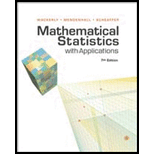
Concept explainers
Let Y1, Y2, … , Yn denote a random sample from a
a If μ is unknown and σ2 is known, show that
b If μ is known and σ2 is unknown, show that
c If μ and σ2 are both unknown, show that
a.
Prove that if µ is unknown and
Answer to Problem 38E
It is proved that if µ is unknown and
Explanation of Solution
Let
The likelihood function is given as follows:
Where
By Theorem 9.4 (Factorization theorem), it can be said that if µ is unknown and
b.
Prove that if µ is known and
Answer to Problem 38E
It is proved that if µ is known and
Explanation of Solution
The likelihood function is given as follows:
Where
By Theorem 9.4 (Factorization theorem), it can be said that if µ is known and
c.
Prove that if both µ and
Answer to Problem 38E
It is proved that if both µ and
Explanation of Solution
The likelihood function is given as follows:
Where
By Theorem 9.4 (Factorization theorem), it can be said that if both µ and
Want to see more full solutions like this?
Chapter 9 Solutions
Mathematical Statistics with Applications
- Should you be confident in applying your regression equation to estimate the heart rate of a python at 35°C? Why or why not?arrow_forwardGiven your fitted regression line, what would be the residual for snake #5 (10 C)?arrow_forwardCalculate the 95% confidence interval around your estimate of r using Fisher’s z-transformation. In your final answer, make sure to back-transform to the original units.arrow_forward
- BUSINESS DISCUSSarrow_forwardA researcher wishes to estimate, with 90% confidence, the population proportion of adults who support labeling legislation for genetically modified organisms (GMOs). Her estimate must be accurate within 4% of the true proportion. (a) No preliminary estimate is available. Find the minimum sample size needed. (b) Find the minimum sample size needed, using a prior study that found that 65% of the respondents said they support labeling legislation for GMOs. (c) Compare the results from parts (a) and (b). ... (a) What is the minimum sample size needed assuming that no prior information is available? n = (Round up to the nearest whole number as needed.)arrow_forwardThe table available below shows the costs per mile (in cents) for a sample of automobiles. At a = 0.05, can you conclude that at least one mean cost per mile is different from the others? Click on the icon to view the data table. Let Hss, HMS, HLS, Hsuv and Hмy represent the mean costs per mile for small sedans, medium sedans, large sedans, SUV 4WDs, and minivans respectively. What are the hypotheses for this test? OA. Ho: Not all the means are equal. Ha Hss HMS HLS HSUV HMV B. Ho Hss HMS HLS HSUV = μMV Ha: Hss *HMS *HLS*HSUV * HMV C. Ho Hss HMS HLS HSUV =μMV = = H: Not all the means are equal. D. Ho Hss HMS HLS HSUV HMV Ha Hss HMS HLS =HSUV = HMVarrow_forward
 Glencoe Algebra 1, Student Edition, 9780079039897...AlgebraISBN:9780079039897Author:CarterPublisher:McGraw Hill
Glencoe Algebra 1, Student Edition, 9780079039897...AlgebraISBN:9780079039897Author:CarterPublisher:McGraw Hill
